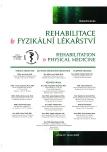Effect of the Canis Therapy on Autonomic Nervous System, Evaluated by Indices of Spectral Analysis of Heart Rate Variability
Authors:
P. Uhlíř
Authors‘ workplace:
Katedra fyzioterapie FTK UP v Olomouci, vedoucí katedry PhDr. D. Smékal, Ph. D.
Published in:
Rehabil. fyz. Lék., 27, 2020, No. 2, pp. 81-86.
Category:
Original Papers
Overview
This article focuses on the evaluation of the canis therapy relaxing positioning on autonomic nervous system by parameters of heart rate variability in healthy probands.
In this study, a statistically significant increase of indices of spectral analysis of heart rate variability in frequency domain (Power HF, Total Power) and time domain (RR intervals) after the canis therapy relaxing positioning were found. This could be related with positive effect of canis therapy on cardiac autonomic regulation.
Keywords:
autonomic nervous system – heart rate variability – spectral analysis – canis therapy relaxation positioning
Sources
1. Botek, M., Stejskal, P., Jakubec, A., Kalina, M.: Kvantifikace aktivity autonomního nervového systému v zotavení s možností monitorování procesu superkompenzace metodou spektrální analýzy variability srdeční frekvence. In Sborník článků ze 4. mezinárodního semináře Variabilita srdeční frekvence a její hodnocení v biomedicínckých oborech – od teorie ke klinické praxi 2003, Olomouc, Univerzita Palackého, s. 10-17.
2. Cicholesová, T.: Canisterapia – pomocná terapia s posobením psa. Rehabilitácia 43, 2006, 2, s. 114-117.
3. Crawford, J., Pomerinke, K.: Therapy Pets, New York, Prometheus Books, 2003, s. 23-24.
4. Eisertová, J.: Terapie za asistence psa u klienta s hyperkinetickým syndromem (ADHD). Sborník příspěvků odborné konference s mezinárodní účastí 2008. Praha, Česká zemědělská univerzita, s. 111-115.
5. Ellis, R. J., Thayer, J. F.: Music and autonomic nervous system dysfunction. Music Percept, 27, 2010, 4, s. 317-326.
6. Franč,ová, E., Hutařová, I.: Co je vlastně asistenční pes? Humpolec, David, 2005, s. 20-25.
7. Greiffenhagen, S., Buck-Werner, O.: Tiere als Terapie: Neue Wege in Erziehung und Heilung. Mürlenbach, Kynos Verlag, 2007, s. 60-65.
8. Javorka, K. et al.: Variabilita frekvencie srdca. Mechanizmy hodnotenie, klinické využitie, Martin, Osveta, 2008, s. 33.
9. Kalinová, V.: Evaluation of integration summer canisterapeutic camps. Journal of Health Sciences Management and Public Health, 2005, s. 272-280.
10. Kalinová, V.: Canistherapy as supporting rehabilitation metod in Czech republic. Journal of Health Sciences Management and Public Health, 7, 2006, 2, s. 261-271.
11. Legl, T.: Tiergestützte Therapie in der Behandlung von Sucht kranken. 1. Internationales TAT-Symposium „Tiere als Therapie-Theorie und Praxis“, Wien, 2002, s. 32-36.
12. Lejčarová, A., Skálová, M.: The use of canistherapy in a child with hyperkinetic syndrome. Zdravotně sociální vědy, 11, 2009, s. 413-423.
13. Nerandžič, Z.: Animoterapie, aneb Jak nás zvířata léčí. Praha, Albatros, 2006, s. 48-53.
14. Novotná, D., Turčanová, J., Vyškov, P.: Normy praxe. Mezinárodní seminář o zooterapiích 1.- 3. 7. 2005, Brno, Filia, s. 9-10.
15. Opavský, J.: Autonomní nervový systém a diabetická autonomní neuropatie: Klinické aspekty a diagnostika, Praha, Galén, 2002, s. 164-169.
16. Otterstedt, C.: Tiere als therapeutische Begleiter, Stuttgart, Kosmos, 2001, s. 80-89.
17. SALINGER, J., ŠTĚPANÍK, J., KREJČÍ, J., STEJSKAL, P.: Non invasive investigation of the function of the autonomic nervous system with the use of the VarCor PF7 system. In Z. Borysiuk (Ed.), 5th International Conference Movement and Health-proceedings, Opole: Opole University of Technology, 2006, s. 486-493.
18. Stejskal, P.: Využití nové metodiky hodnocení SA HRV pomocí komplexních indexů v klinické a sportovní praxi. In Sborník článků ze 4. mezinárodního semináře Variabilita srdeční frekvence a její hodnocení v biomedicínckých oborech – od teorie ke klinické praxi, Olomouc, Univerzita Palackého v Olomouci, 2003, s. 81-85.
19. Stejskal, P., Salinger, J.: Spektrální analýza variability srdeční frekvence. Základy metodiky a literární přehled o jejím klinickém využití. Medicina Sportiva Bohemica & Slovaca, 2, 1996, s. 33-42.
20. Uhlíř, P.: Efekt relaxačního programu audiovizuální stimulace na autonomní nervový systém, hodnocený vybranými ukazateli spektrální analýzy variability srdeční frekvence. Rehabilitace a fyzikální lékařství, 26, 2019, 2, s. 74-80.
21. Uhlíř, P., Opavský, J.: Autonomní reaktivita u pacientů s ischemickou srdeční chorobou po aortokoronárním bypassu před kardiorehabilitací. Rehabilitace a fyzikální lékařství, 23, 2016, 3, s. 136-141.
22. Uhlíř, P., Opavský, J., Zaatar, A., Betlachová, M., Knap, J., Klapalová, A.: Autonomní reaktivita u osob s postižením lokomoce po poranění míchy, Česká kinantropologie, 14, 2010, 4, s.72-81.
23. Zouharová, M.: Canisterapeutická kuchařka, aneb metody canisterapie. Praha, SVOPAP, 2002, s. 77-82.
24. Velemínský, M.: Zooterapie ve světle objektivních poznatků. České Budějovice, Dona, 2007, s. 96-98
Labels
Physiotherapist, university degree Rehabilitation Sports medicineArticle was published in
Rehabilitation & Physical Medicine

2020 Issue 2
Most read in this issue
- Piriformis Syndrome and FAIR Test from the View of Magnetic Resonance
- Evaluation Dynamic Postural Stability – Creation of Reference Values for a Common Young Population in the Czech Republic
- The Influence of Phy-siotherapy for Female Urinary Incontinence
- Practical Use of PolyEMG in Rehabilitation. Poutpatient’s. Surface Electromyography (SEMG) and EMG Biofeedback
